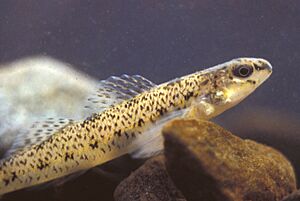Johnny darter facts for kids
Quick facts for kids Johnny darter |
|
|---|---|
 |
|
| Conservation status | |
| Scientific classification | |
| Synonyms | |
|
The johnny darter (Etheostoma nigrum) is a small freshwater fish. It belongs to a group of fish called darters. These fish are part of the same family as perches. You can find johnny darters in shallow waters across North America, especially east of the Rocky Mountains.
Contents
What's in a Name?
The johnny darter's scientific name, Etheostoma nigrum, has a cool meaning! The first part, Etheostoma, comes from ancient Greek words. Etheo means "to filter," and stoma means "mouth." The second part, nigrum, is Latin for "black." So, its name tells us a bit about its mouth and its color!
Where Do Johnny Darters Live?
Johnny darters live in many places! You can find them from Saskatchewan in Canada down to Colorado in the United States. They also live all the way to the Atlantic Ocean. From Hudson Bay in the north, they spread south to the Gulf Coast. They are super common in states like Minnesota and Ohio.
What Do Johnny Darters Look Like?
Johnny darters are small and slender fish. Most of them grow to be about 3.9 centimeters (about 1.5 inches) long. The biggest ones can reach up to 7.2 centimeters (about 2.8 inches). Males are a little heavier than females.
These fish usually have brown or yellow scales. Their sides are paler, and their bellies are whitish. They don't have bright colors. Instead, they have brown or black markings on a lighter tan background. These markings often look like "w" or "x" shapes along their sides. This pattern runs along their lateral line, which is a special line of sensors fish use to feel vibrations in the water.
Johnny darters have two dorsal fins on their back. The first one has stiff, spiny rays, while the second one is soft and flexible. Their pectoral fins (like arms) are large and fan-shaped, located on their lower sides. Their pelvic fins (like legs) are small and round, found underneath them. They also have a rounded tail fin.
Home, Food, and Who Eats Them
Johnny darters love clear water with sandy or gravelly bottoms. They prefer slow-moving water, but they can also live in slightly cloudy, moving water. They are "bottom dwellers," meaning they stay on rocks at the bottom of small ponds and streams. They often face their heads into the water current.
These darters are quite tough! They can handle more different water conditions than most other darter species. Since they live on the bottom, their mouth is slightly underneath their nose. This makes it easy for them to find and eat food on the ground.
When they are young, johnny darters eat tiny creatures like copepods (small crustaceans) and waterfleas. As they grow bigger, they start eating larger waterfleas and different kinds of insect larvae. This includes larvae of midges, mayflies, and caddisflies. Sometimes, they might even eat a sideswimmer, which is another small crustacean.
Bigger fish like burbots, lake trout, smallmouth bass, walleyes, and yellow perch often eat johnny darters.
Life Cycle and Reproduction
Johnny darters usually lay their eggs in May and June. This happens when the water temperature is between 12 and 24 degrees Celsius (54 to 75 degrees Fahrenheit).
Male darters arrive first to find and claim their own special spots in the pond, lake, or stream. These spots are usually in shallow water, pools, or slow-moving areas. They look for large rocks, logs, cans, shells, or other debris to use as a nest.
When a female comes near a male's nest, he might chase her away at first. But if she approaches the nest upside down and tries to enter, he will accept her. Then, both the male and female turn upside down. The female lays between 30 and 200 eggs on the underside of the chosen object.
Johnny darters don't just mate with one partner. Both the female and male will spawn with other fish. One single nest can end up holding as many as 1000 developing eggs! The male darter is a good dad. He guards the nest and keeps the eggs supplied with oxygen. He will even eat any eggs that start to grow fungus. The baby darters hatch after about six to ten days.
Are Johnny Darters Safe?
Good news! Most johnny darters are not considered to be in danger. They are only thought to be vulnerable (meaning they could become threatened) in a few states like Arkansas, Kentucky, Oklahoma, Kansas, and Nebraska. In Minnesota, they don't have a special conservation status, but state laws still protect them.


